
Detail of Thomas Fry and Peter Jefferson’s A MAP of the most INHABITED part of VIRGINIA containing the whole PROVINCE of MARYLAND with part of PENSYLVANIA, NEW JERSEY and NORTH CAROLINA, London, 1768. (Courtesy, Colonial Williamsburg Foundation.)

Desk signed by Christopher Frye and James Lee Martin, Fauquier County, Virginia, 1797. Walnut with yellow pine and tulip poplar. H. 41 3/4", W. 43 3/4", D. 21 1/2". (Private collection; photo, Craig McDougal.) The desk originally had a bookcase, and its feet are replaced.
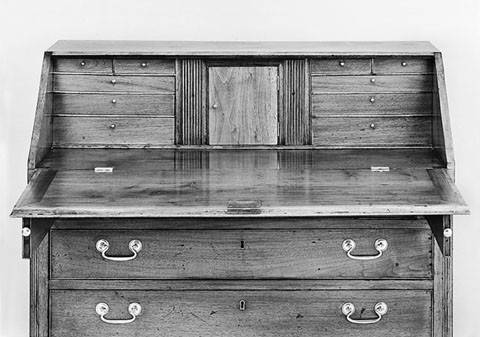
Detail of the interior of the desk illustrated in fig. 2.

Detail of the inscription on the secret drawer of the desk illustrated in fig. 2.
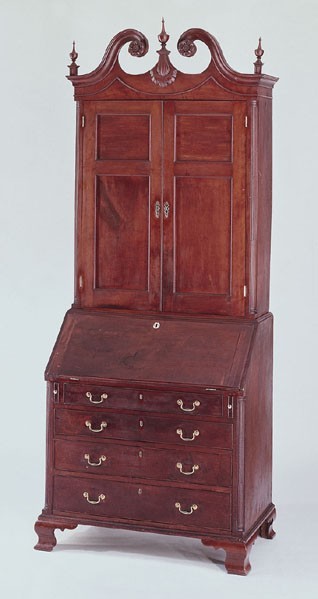
Desk-and-bookcase attributed to the Frye-Martin shops, Winchester area, Virginia, 1791–1794. Cherry with yellow pine. H. 103 3/4", W. 42 1/4", D. 24 1/2". (Courtesy, Colonial Williamsburg Foundation.) This example and the high chests illustrated in figs. 9 and 14 have their original finials and most of their original brasses.
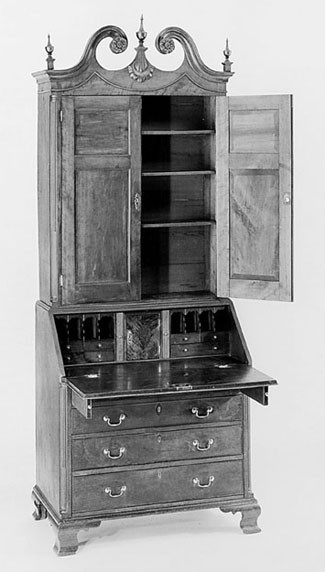
View of the desk-and-bookcase illustrated in fig. 5 with door and fallboard open.
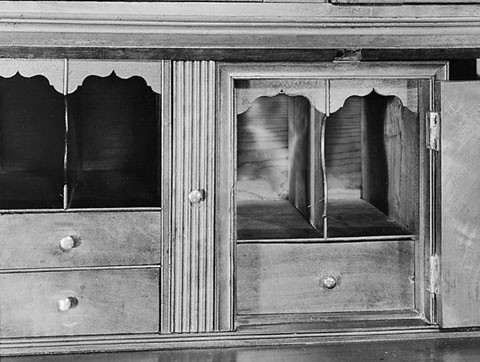
Detail of the interior of the desk-and-bookcase illustrated in fig. 5, showing a fluted document drawer and the prospect compartment open. The mitered molding above the door is the face of a secret drawer. A card table that descended in the Lupton family (CWF 1987-725) has a top with a molded edge of the same configuration as the molding around the prospect door.
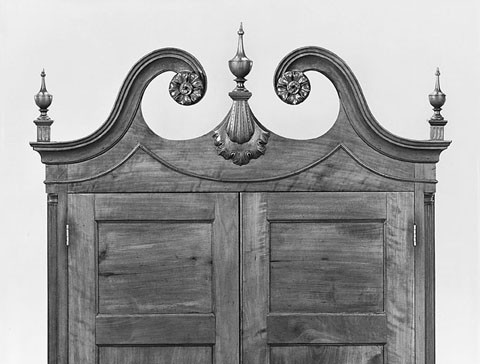
Detail of the pediment of the desk-and-bookcase illustrated in fig. 5.
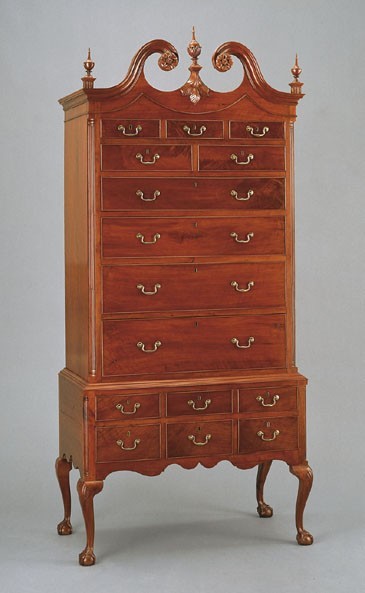
High chest with cabriole legs attributed to the Frye-Martin shops, Winchester area, Virginia, 1791–1794. Cherry with yellow pine. H. 97", W. 44", D. 24 1/4". (Courtesy, Colonial Williamsburg Foundation.)
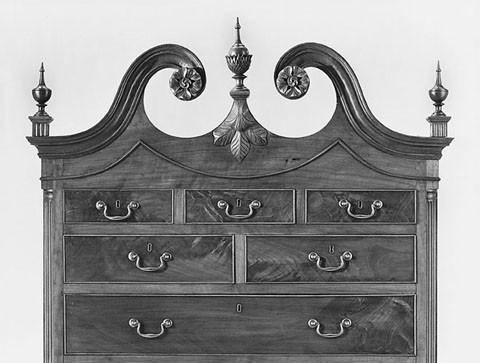
Detail of the pediment of the high chest with cabriole legs illustrated in fig. 9.
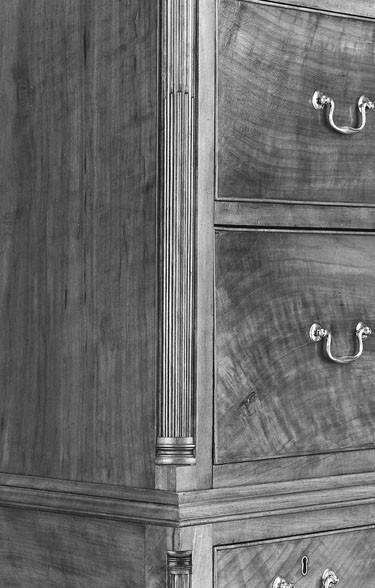
Detail of an arched, stop-fluted quarter-column on the upper section of the high chest with cabriole legs illustrated in fig. 9.
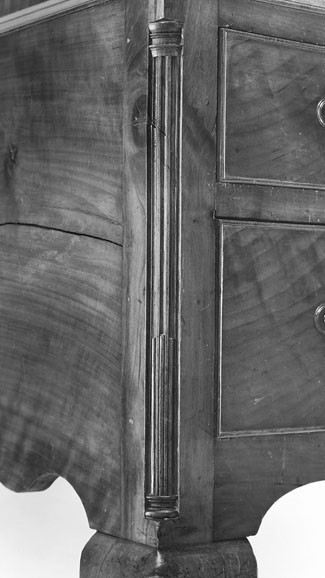
Detail of an arched, stop-fluted quarter-column on the lower section of the high chest with cabriole legs illustrated in fig. 9. This quarter-column is carved from the stile rather than being turned and fluted on a lathe like the columns on the upper section.
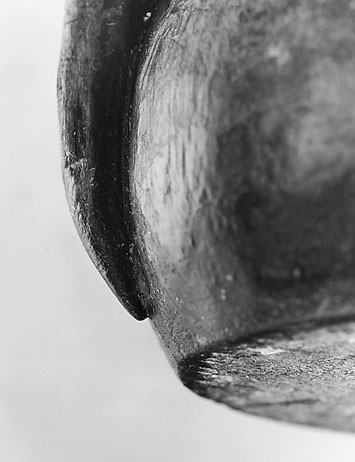
Detail of a claw-and-ball foot of the high chest with cabriole legs illustrated in fig. 9.
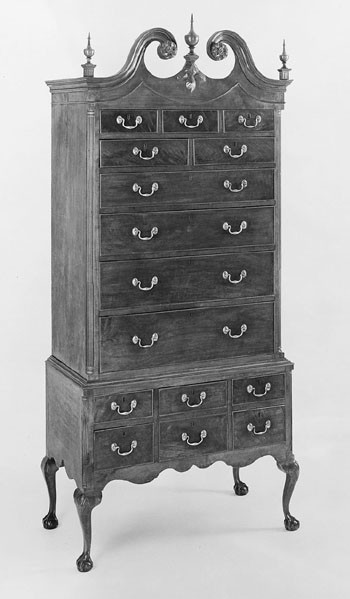
High chest with cabriole legs attributed to the Frye-Martin shops, Winchester area, Virginia, 1791–1794. Cherry with yellow pine. H. 97 1/2", W. 44", D. 24". (Courtesy, Colonial Williamsburg Foundation.)
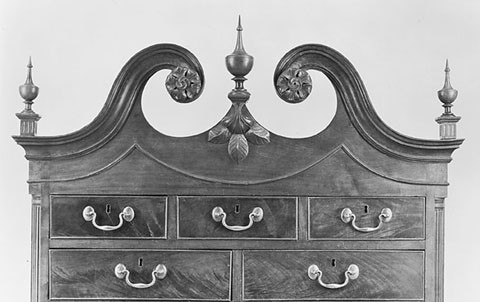
Detail of the pediment of the high chest with cabriole legs illustrated in fig. 14.
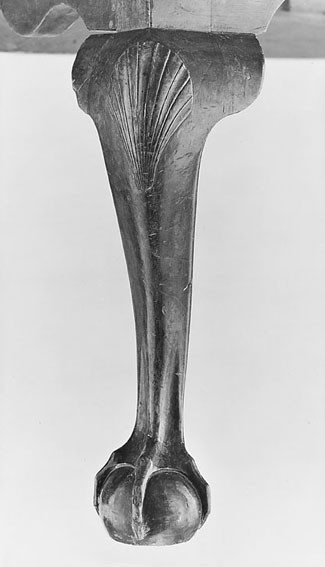
Detail of a front leg of the high chest with cabriole legs illustrated in fig. 14.
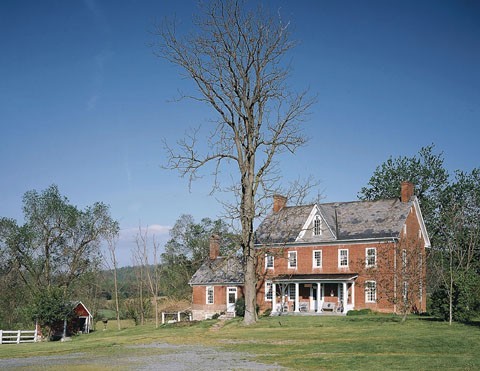
Cherry Row, Frederick County, Virginia, completed 1794. (Photo, Gavin Ashworth.)

Detail of the carved date board on the exterior of Cherry Row. (Photo, Gavin Ashworth.)

Base of a high chest with cabriole legs, Winchester area, Virginia, 1791–1794. Walnut with tulip poplar. Dimensions not recorded. (Private collection; photo, Wallace Gusler.) This base may have supported a separate case of drawers, or it may be the lower part of a single-piece form.
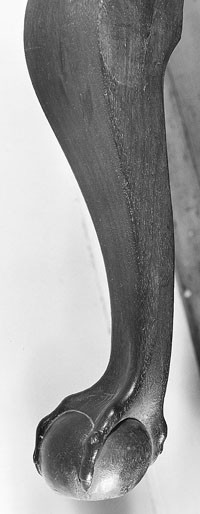
Detail of a leg of the high chest base illustrated in fig. 19.
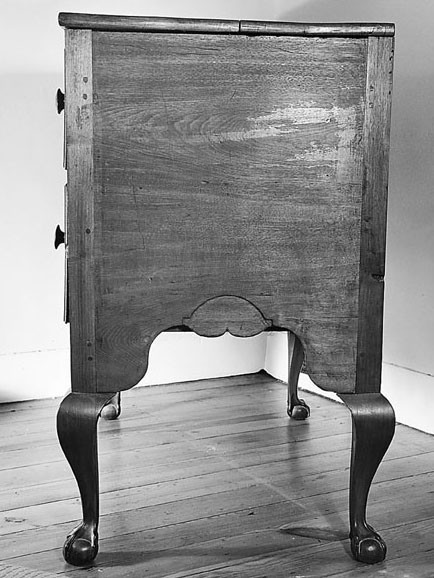
Detail of the right side of the high chest base illustrated in fig. 19.

Tall clock case attributed to the Frye-Martin shops, Winchester area, Virginia, ca. 1795. Walnut with yellow pine. H. 99 1/2". (Private collection; photo, Craig McDougal.) The movement is not signed. The tips of the ogee feet are missing. The door has scars from modern, surface-mounted false hinges, but the original hinges are intact.
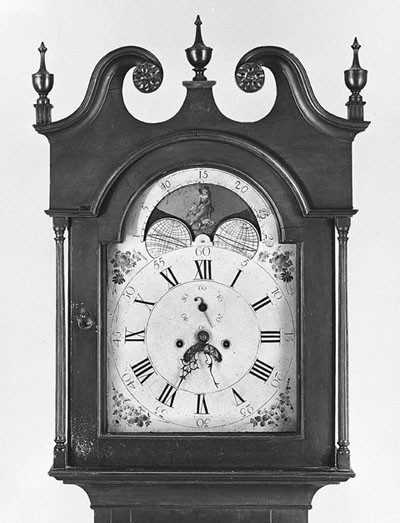
Detail of the hood of the tall clock case illustrated in fig. 22.
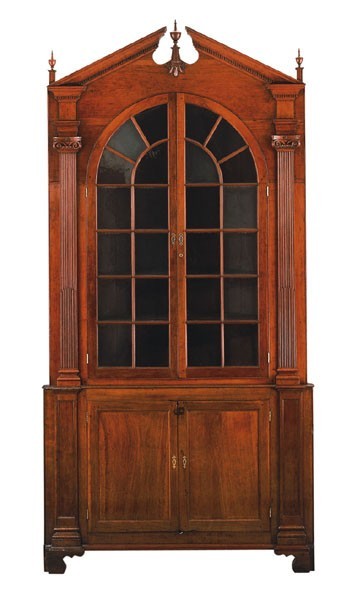
Corner cupboard attributed to the Frye-Martin shops, Winchester area, Virginia, ca. 1790. Cherry and mahogany (capitals) with yellow pine. H. 125", W. 61", D. 24". (Courtesy, Colonial Williamsburg Foundation.) The shelves are faced with applied strips with scalloped
lower edges.
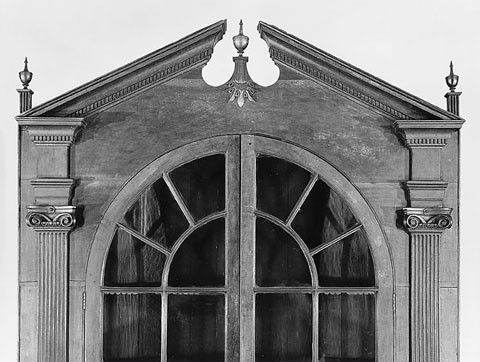
Detail of the pediment of the corner cupboard illustrated in fig. 24.
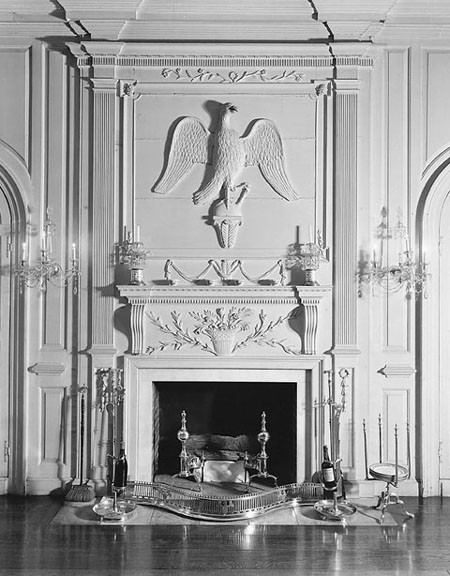
Overmantle from the James Hamilton House, Kernstown, Virginia, ca. 1800. Painted yellow pine. (Courtesy, Winterthur Museum.) The eagle has been removed from its original position shown here and reinstalled in another location in the Winterthur Museum.
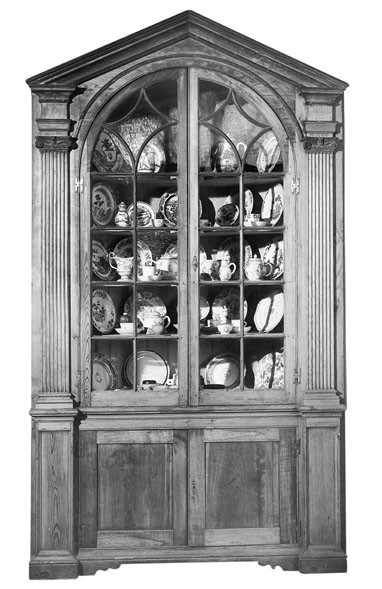
Corner cupboard, Winchester area, Virginia, ca. 1790. Yellow pine, walnut (capitals), and maple (shell) with yellow pine; linen lining; traces of original blue paint inside and out. Dimensions not recorded. (Courtesy, Piaget, St. Louis.)

Corner cupboard in Cherry Row, Frederick County, Virginia, completed ca. 1794. Yellow pine and maple (capitals) with yellow pine; linen lining; traces of original blue paint inside and out. Dimensions not recorded. (Private collection; photo, Gavin Ashworth.)
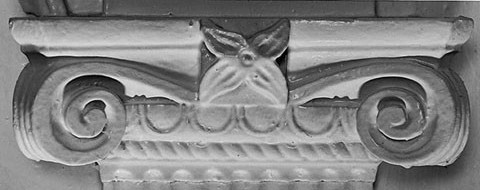
Detail of a capital on the corner cupboard illustrated in fig. 28. (Photo, Gavin Ashworth.)

Detail of a capital on the corner cupboard illustrated in fig. 27.
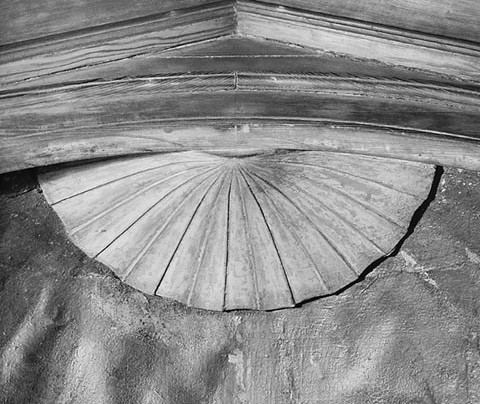
Detail of the carved shell in the interior of the corner cupboard illustrated in fig. 27.

Detail of a carved capital in Belle Grove, Frederick County, Virginia, ca. 1795. (Courtesy, Belle Grove Plantation; photo, Wallace Gusler.)
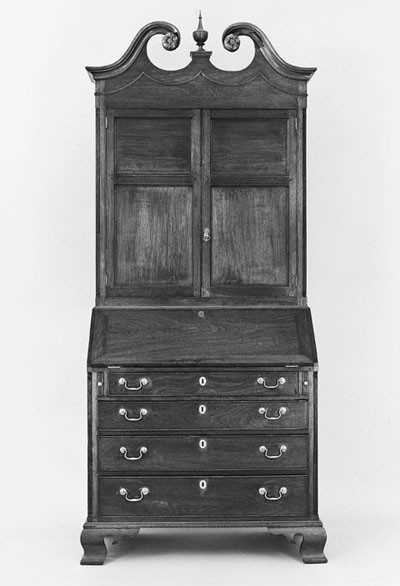
Desk-and-bookcase, Winchester area, Virginia, ca. 1800. Walnut with yellow pine.
H. 93", W. 41 1/4", D. 23". (Private collection; photo, Craig McDougal.) The feet, finial, and rosettes are restorations based on the Lupton desk-and-bookcase (fig. 5) and the tall clock case shown in fig. 22.
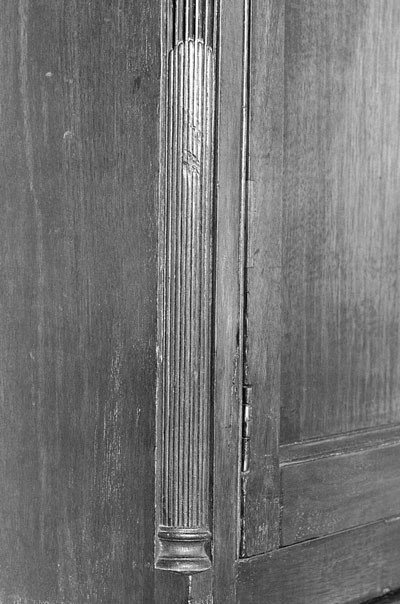
Detail of an arched, stop-fluted, quarter-column on the desk-and-bookcase illustrated in fig. 33. (Photo, Museum of Early Southern Decorative Arts.)
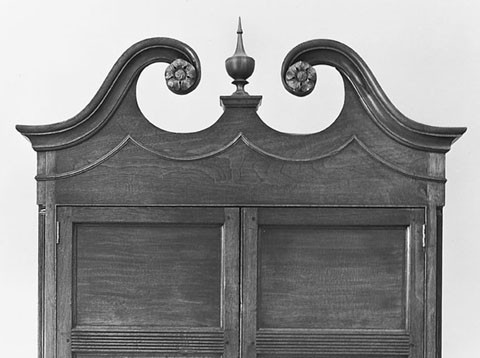
Detail of the pediment of the desk-and-bookcase illustrated in fig. 33.
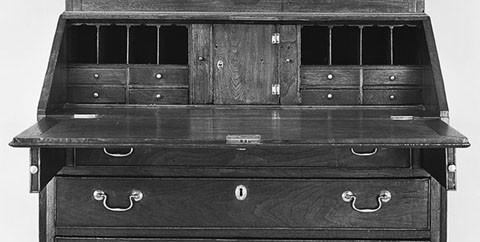
Detail of the interior of the desk-and-bookcase illustrated in fig. 33.
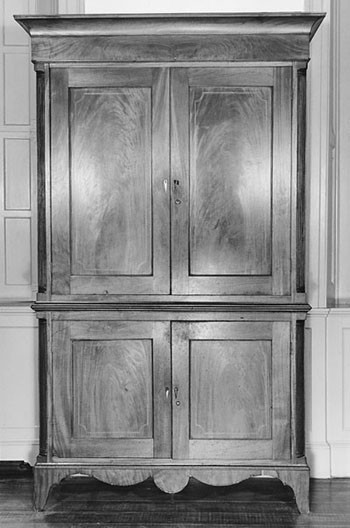
Clothespress, Winchester area, Virginia, ca. 1815. Mahogany and mahogany veneer with yellow pine. Dimensions not recorded. (Courtesy, Belle Grove Plantation.)
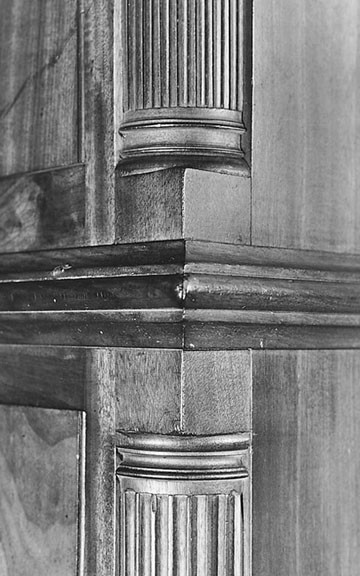
Detail of the capitals on the upper and lower sections of the clothespress illustrated in fig. 37.

High chest, Winchester area, Virginia, ca. 1795. Walnut with yellow pine. H. 84", W. 48", D. 23". (Private collection; photo, Wallace Gusler.) The feet are replacements.
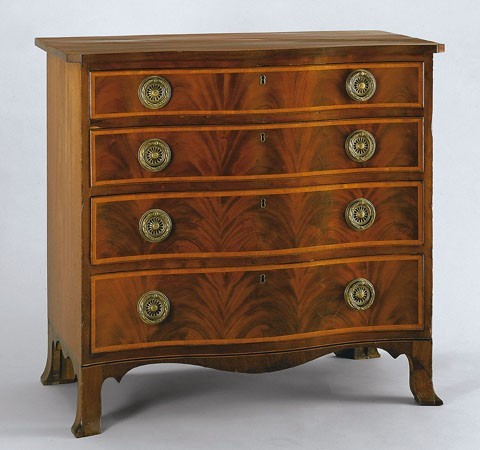
Chest of drawers, Winchester area, Virginia, ca. 1790. Mahogany, mahogany veneer, and apple with yellow pine. H. 36 1/8", W. 39", D. 20 3/4". (Private collection; photo, Craig McDougal.)
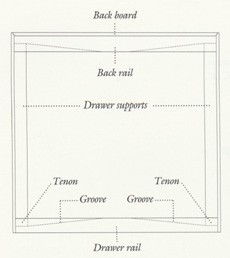
Plan of the drawer support system of the chest of drawers illustrated in fig. 40. (Drawing, Wallace Gusler; artwork, Wynne Patterson.)
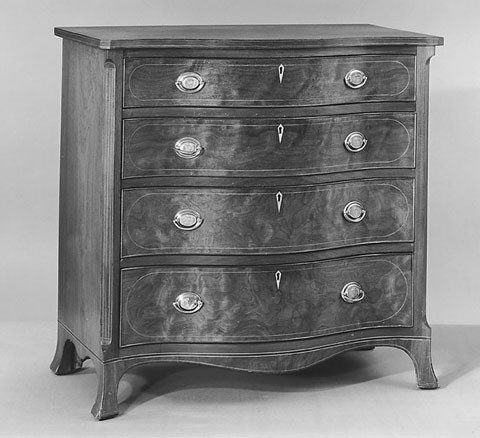
Chest of drawers, Winchester area, Virginia, ca. 1810. Walnut with yellow pine. H. 37 5/8", W. 38", D. 21 7/8". (Courtesy, Colonial Williamsburg Foundation.)
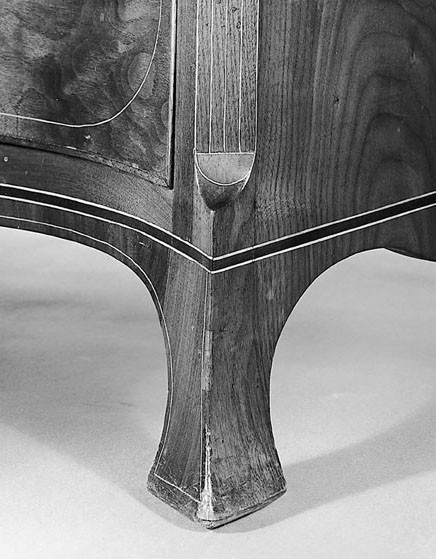
Detail of the foot of the chest of drawers illustrated in fig. 42.
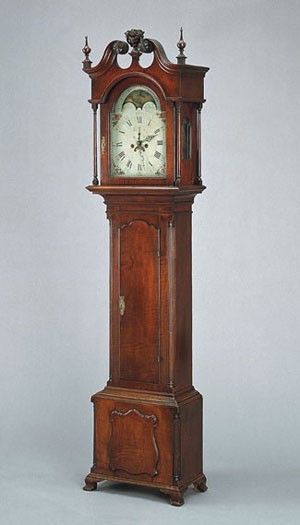
Tall clock case, Winchester area, Virginia, ca. 1790. Curly maple with yellow pine and walnut. H. 87 3/4", W. 22 1/4", D. 12 1/4". (Courtesy, Colonial Williamsburg Foundation.)

Detail of the hood of the tall clock case illustrated in fig. 44.
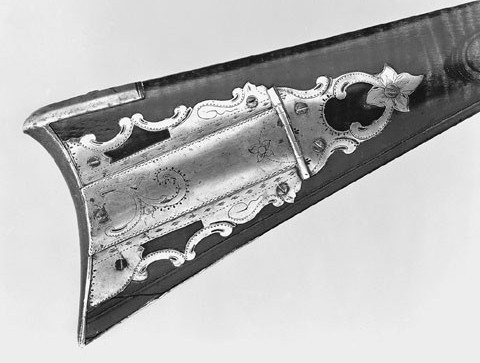
Detail of the brass patchbox on a rifle signed “J. Haymaker,” Winchester, Virginia, ca. 1790. Curly maple, iron, steel, brass, and silver. L. 60". (Private collection; photo, Craig McDougal.) Haymaker’s work reflects an acute understanding of the rococo style and its application to woodcarving, brass work, and engraving. From the standpoint of design and workmanship, the products of the city’s riflemaking school are far more sophisticated than those of the furniture-making school.
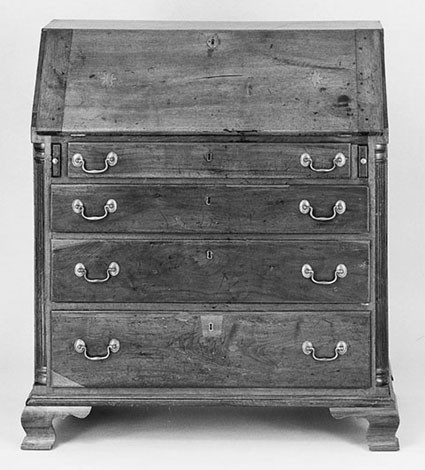
Desk, Winchester area, Virginia, ca. 1800. Walnut and maple inlay with yellow pine and tulip poplar. H. 44 3/8", W. 40 3/4", D. 21 3/4". (Private collection; photo, Craig McDougal.) The desk has arched, stop-fluted quarter-columns and other features associated with the Frye-Martin shops. The interior has a central prospect door flanked by four equal-sized drawers (two over two). Above the drawers are three pigeonholes with arched valances. The prospect door of the interior has the initials “I·F” inlaid in maple.
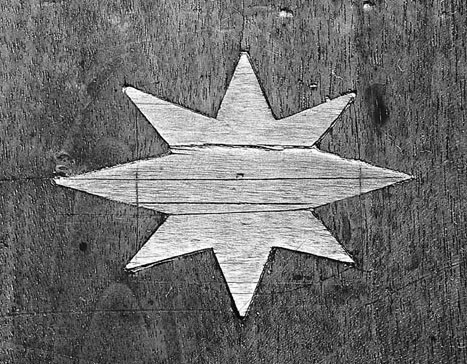
Detail of the star inlay on the fallboard of the desk illustrated in fig. 47.

Detail of the cheek rest of the rifle illustrated in fig. 46, showing the silver “hunter’s star” inlay.
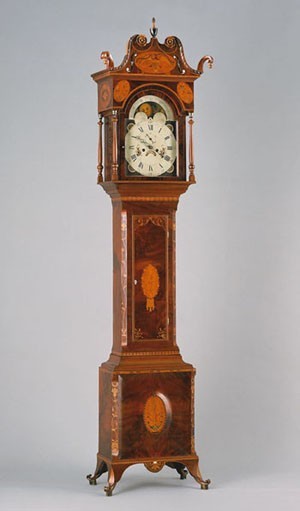
Tall clock case attributed to Peter Raff with movement attributed to Peter Whipple, Pulaski County, Virginia, ca. 1815. H. 10 8 1/2", W. 24", D. 15". (Courtesy, Colonial Williamsburg Foundation.)

Detail of the hood of the tall clock case illustrated in figure 50.
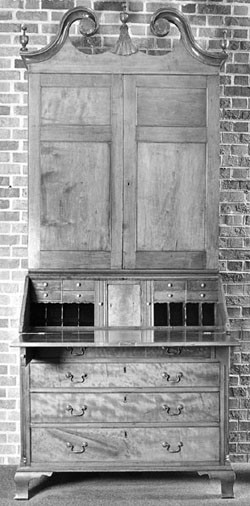
Desk-and-bookcase, Knoxville, Tennessee, ca. 1810. Cherry with yellow pine and tulip poplar. H. 96" (minus feet), W. 42", D. 20". (Courtesy, Lawson McGhee Library; photo, Museum of Early Southern Decorative Arts.)
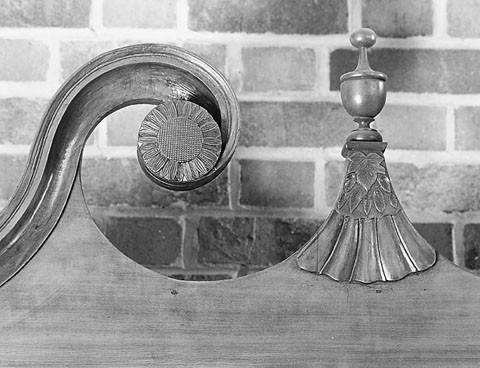
Detail of the pediment of the desk-and-bookcase illustrated in fig. 52.
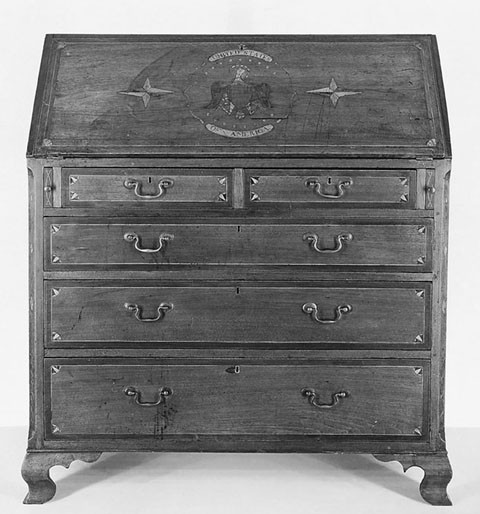
Desk, Virginia or Tennessee, 1808. Walnut and maple inlay with tulip poplar. H. 47 1/4", W. 42", D. 20". (Courtesy, Winterthur Museum.)
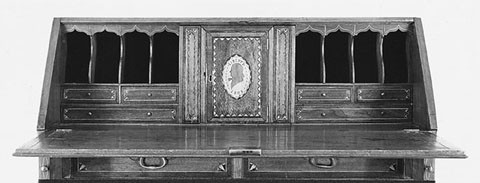
Detail of the writing compartment of the desk illustrated in fig. 54. The mitered molding above the door is the face of a secret drawer.
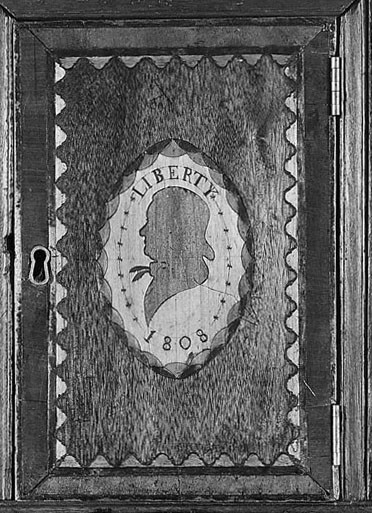
Detail of the prospect door of the desk illustrated in fig. 54.
